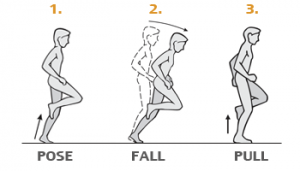THURSDAY
I hope you’re all thinking about joining the CMC team!! Sign up now while you can use the discount codes!! Today you can choose between one of two workouts. If you want to bypass the strength and get right to the endurance workout, do it!! I expect to see everyone today.
What is “Pose Running”?
The Pose Method was developed by Dr. Nicholas Romanov in 1977. Romanov was a coach in Russia, heavily involved in athlete training. At a time when the focus was on improving mileage and speed through simply increasing an athlete’s cardiovascular and respiratory systems, Romanov used physics to evaluate overall running technique.

The Pose Method
Running with a heel strike is one of the primary cause of shin splints. In an effort to alleviate this problem running shoe companies have been adding more cushion to the heel of running shoes. Over the years these “shock absorbers” have increased in height. The question is, what are these heels possibly doing to the rest of my body? Stay tuned for some answers in Thursday’s post.
*The information in this post came from the article “Pose running technique: a beginner’s guide” found on the PoseTech website. Click here for the full article.
STRENGTH:
Bench press
3/3/3/3/3
CrossFit WOD:
8 rds:
Run 400 meters
Rest 90 seconds
OR
16 intervals of:
250 meter row
Rest :30 sec
Time your 400 meter runs and try to stay within 5 seconds each interval. If you choose to row, try to stay at the same split time and strokes.
